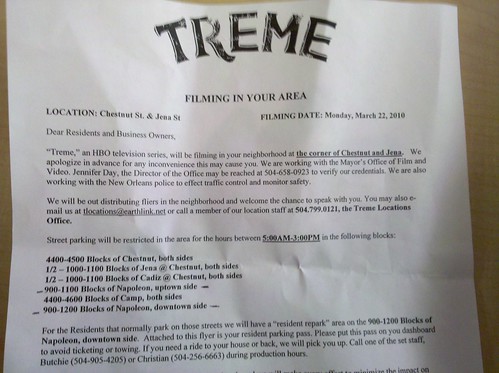
Fun facts about filming in New Orleans:
In New Orleans, filmmakers have it made when it comes to setting up shop.
No permit is needed, just a request by City Hall to check in. The city’s film office, with three employees, fields complaints, calls and questions, and acts as a liaison for disgruntled residents wondering when street parking will be available.
Crews must abide by parking regulations, said Jennifer Day, director of the city’s Office of Film and Video. They must also abide by the rules of any agency that oversees the location. Filming in Jackson Square, for example, requires strict compliance with the parks department.
“They call it ‘film-friendly,’” said Day. “One of the reasons we are attracting the business from California is that they have come up with such strict guidelines. Because of the unprecedented success we have had, there are some issues.”
In last week's Gambit, Chris Rose summarized the most recent round of controversy between New Orleans Police and Mardi Gras Indian tribes over their use of the public streets.
The cops and other public critics of the Indians — and there are more than a few — have come to resent the Indians' casual flouting of city permit laws, particularly when it comes to providing parade route maps and details. But that's just the thing: There is no route.
And there are no rules. And this is why a unique accord needs to be crafted by a forward-thinker from City Hall — which doesn't seem in the offing; Ray Nagin's administration has chosen its usual course of indifference to deal with this controversy.
The thing is, the whole mystique behind the Indians' elaborate street theater is that observers who want to get near the action don't actually know when and where the tribes will be gathering. For instance, this Friday, March 19, is St. Joseph's Day, the biggest nighttime event of the year for the Indian Nation. Some 20 to 30 gangs will dress and prep all over town in the same fashion as float riders in a Mardi Gras parade.
The entire premise of the unfolding drama is based on assorted spy boys, flag boys and wild men to prance and sneak up and down streets, communicating by whistle and flag, literally playing an advanced-form adult version of hide-and-seek. Eventually, the Big Chiefs are led to each other by their underlings and the dance is on, accompanied by flurries of insults and challenges that might make even the saltiest of rappers blush. The Big Chiefs argue over who's prettiest like bantams strutting the barnyard. Then the steely veneers of the Chief and his underlings melt away, hugs and handshakes are exchanged, and the tribes wander off in different directions, looking for more tribes to throw down against.
So, the map thing? Yeah, it doesn't really work. So, what's the solution? To lock it all down with rules and designated parade areas would wind up making Indian culture a museum piece rather a vibrant, living organism. The whole pageantry and ritual would disappear. The point of it all would die.
Rose is right to wonder why no "forward-thinkers" at City Hall have come up with a "unique accord" to accommodate our city's authentic celebrants since obviously they've managed just such an arrangement for the fake ones.
No comments:
Post a Comment